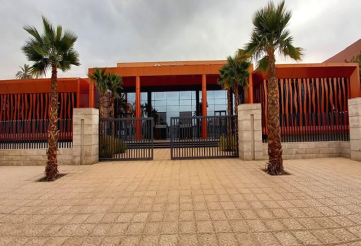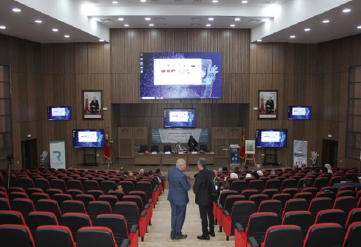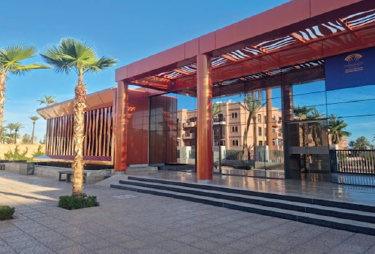
Thermal Sciences and Digitalization:
Towards Intelligent and Sustainable Systems
Marrakech, Morocco – 01 – 03 April 2026

Welcome to AMT’2026 – 9ᵗʰ International Congress on Thermal Sciences
Main Theme:
"Thermal Sciences and Digitalization: Towards Intelligent and Sustainable Systems"
Marrakech, Morocco – 01 – 03 April 2026
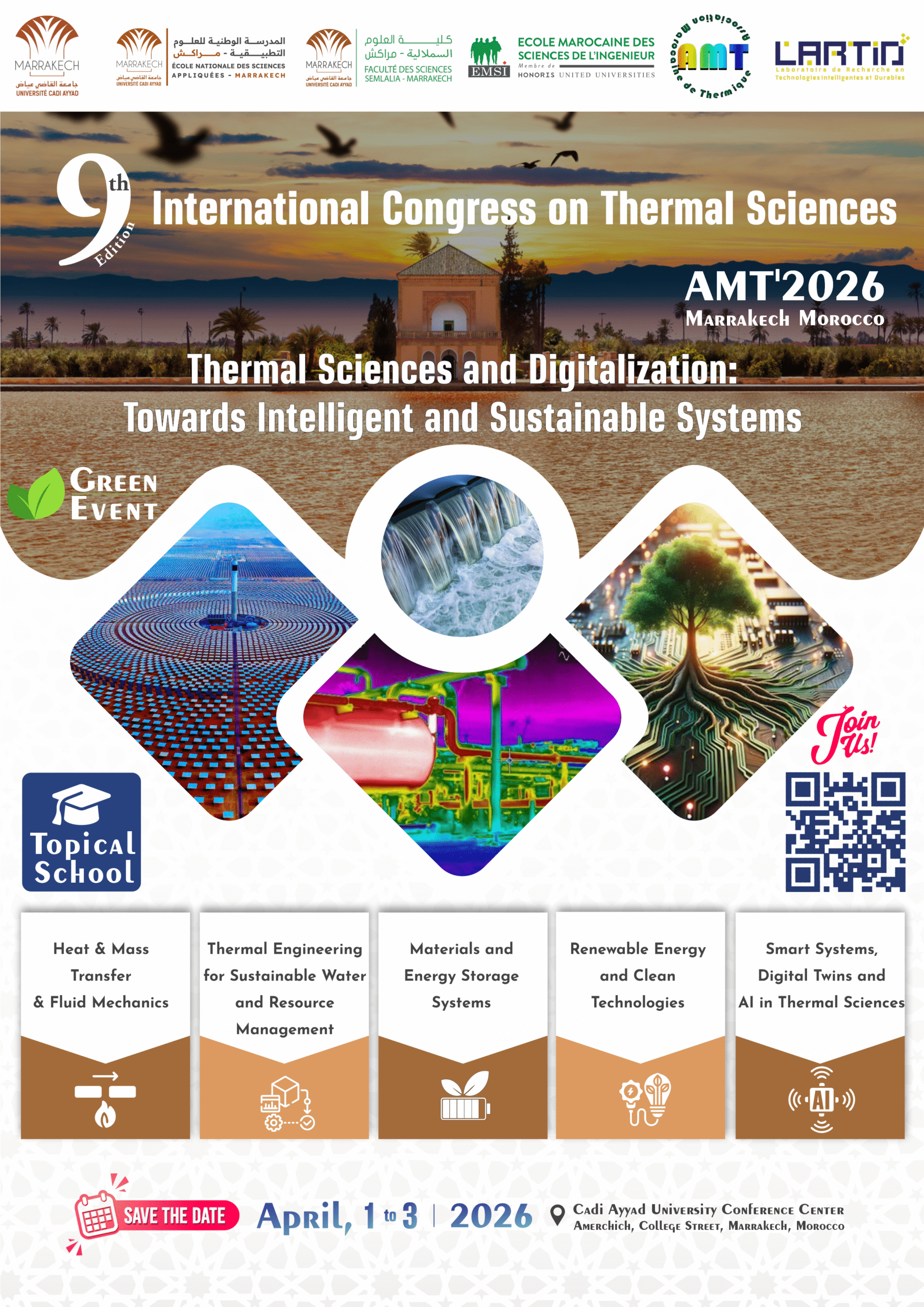
An Exceptional Scientific Event in the Heart of Marrakech
We are pleased to announce the 9ᵗʰ edition of the International Congress on Thermal Sciences – AMT’2026, which will take place in the vibrant and historic city of Marrakech, Morocco. Over the years, AMT congress series has become a key scientific meeting for thermal science experts, engineers, researchers, and industrial stakeholders.
Why Attend AMT’2026?
- A Cutting-Edge Theme : “Thermal Sciences and Digitalization” explores how smart technologies and digital tools such as AI, IoT, and simulation models are revolutionizing thermal engineering and energy systems.
- Networking Opportunities : Connect with leading international experts, industry partners, and researchers from around the world.
- Strategic Location : Marrakech, known for its hospitality and culture, provides an inspiring environment for both scientific exchange and cultural enrichment.
- Keynote Talks and Plenary Sessions : Delivered by globally recognized scientists and innovators in the field.
- Peer-reviewed Proceedings: Possibility of publication in indexed journals and conference proceedings.
Join Us
We extend a warm invitation to academics, researchers, professionals, and PhD students in the field of thermal sciences, energy, and digital engineering to participate in AMT’2026.
You will not only take part as attendees but also share your work as plenary or invited speakers, contributing to the international scientific dialogue.
Let’s shape the future of intelligent and sustainable thermal systems – together in Marrakech, 01 – 03 April 2026!
Prof. Hamza Faraji
President of AMT'2026
on behalf of organizing committee
The 9ᵗʰ International Congress on Thermal Sciences – AMT’2026 is a flagship scientific event that continues the tradition of excellence established by the Moroccan Association of Thermal Sciences (AMT) since 2010. Held every two years, the congress has grown into a key platform for advancing thermal science and its interdisciplinary applications.
In this 2026 edition, the congress aims to address current and future challenges by exploring the intersection between thermal sciences and digital transformation. As digital tools revolutionize modeling, optimization, control, and diagnostics, their integration into thermal and energy systems is opening new frontiers for intelligent and sustainable technologies.
Key Goals of AMT’2026
- Bridge the gap between thermal sciences and digital innovation, enabling smarter and more adaptive energy systems;
- Encourage interdisciplinary collaboration between researchers, engineers, and industry professionals working in thermal science, data science, and system intelligence;
- Support knowledge sharing through high-level scientific sessions, poster presentations, and thematic workshops;
- Highlight research excellence from Morocco and beyond, providing international visibility to cutting-edge work;
- Inspire young researchers and PhD students by fostering a dynamic and inclusive scientific environment.
Strategic Value
This 9ᵗʰ edition is designed to be forward-looking and impact-oriented, offering:
- A thematic structure aligned with global energy priorities and goals;
- An emphasis on applied research and real-world innovations in digitalized and experimental thermal systems;
- A commitment to sustainable event organization, with an ambition to label the congress as a Green Event.
1- Heat and Mass Transfer and Fluid Mechanics:
- Simulation and numerical modeling of heat and mass flows.
- Study of flow behavior in complex thermal systems.
- Applications in heat exchange, industrial processes, and renewable energy systems.
2- Thermal Engineering for Sustainable Water and Resource Management
- Thermal solutions for water treatment, desalination, and reuse;
- Heat-driven processes for resource optimization;
- Coupling of thermal systems with water-energy nexus strategies.
3- Materials and Energy Storage Systems
- Design and testing of advanced materials including PCMs and hybrid nanocomposites;
- Role of thermal materials in hydrogen production, storage, and conversion systems;
- Integration of smart and responsive materials in energy-efficient applications.
4- Renewable Energy and Clean Technologies
- Performance improvement of solar, wind, geothermal, and hydrogen-based systems;
- Thermal integration and hybridization of renewable energy sources;
- Energy efficiency strategies and digital control of clean energy systems.
5- Smart Systems, Digital Twins and AI in Thermal Sciences
- Intelligent modeling and predictive control using AI, machine learning, and optimization algorithms;
- Digital twins for real-time monitoring and system performance forecasting;
- Smart sensor networks for autonomous and connected thermal applications.
| Event | Date |
| Call for papers opens | Soon |
| Paper submission deadline | November 30, 2025 |
| Notification of acceptance | January 15, 2026 |
| Final paper submission | January 31, 2026 |
| Early registration deadline | February 15, 2026 |
| AMT’2026 Conference | April 01 – 03, 2026 |
Submission
Authors are invited to submit their original research contributions to the 9th International Congress on Thermal Sciences (AMT’2026) through the official submission platform:
Guidelines for Authors
- All submissions must be prepared in English and formatted according to the provided templates.
- Templates for Long Papers and Short Papers are available for download under the “Publication Opportunities” section.
- Each paper will be peer-reviewed by at least two independent reviewers.
- All manuscripts will be checked for plagiarism.
- Accepted papers must be presented at the congress (oral or poster presentation).
- References must be accurate, timely, and relevant and should not excessively cite the same authors or publications (to avoid citation manipulation).
- Each reference must include the full title of the article and its DOI (when available).
- Maximum 15 references per article.
- Articles exceeding these limits may be excluded from publication.
Important Notes
- Submissions must be made exclusively via the EasyChair platform; email submissions will not be accepted.
- At least one author of each accepted paper must register and present the work.
- Selected high-quality papers will be invited for publication in special issues or conference proceedings, as detailed in the “Publication Opportunities” section.
Conference Proceedings (Long Papers)
Accepted Long Papers will be published in the Web of Conferences section of The European Physical Journal (EPJ), jointly published by EDP Sciences and Springer.
The EPJ – Web of Conferences series is indexed in Scopus (Elsevier) and Web of Science (Clarivate Analytics), ensuring broad visibility and international recognition.
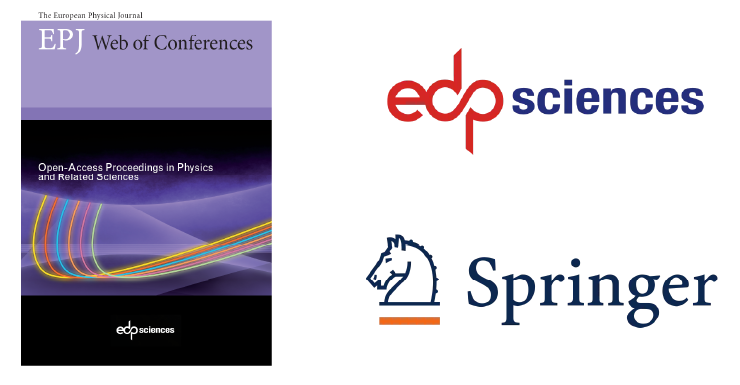
Only high-quality papers that pass the rigorous peer-review process will be selected. Authors must use the official EPJ – Web of Conferences template.
Guest Editors of the proceedings are:
- Prof. Hamza Faraji, ENSA Marrakech, Cadi Ayyad University, Marrakech, Morocco
- Prof. Müslüm Arıcı, Kocaeli University, İzmit, Turkey.
Short Papers
Short Papers are concise communications presenting early-stage research, innovative ideas, or case studies. They will be included in the conference program but will not be published in the proceedings. Authors must use the Short Paper template.
Special Issues in Indexed Journals
In parallel with AMT’2026, a Special Issue is organized in the open-access journal Fluids (MDPI, Impact Factor: 1.8, CiteScore: 4.0).

This Special Issue will host extended versions of selected full papers presented at AMT’2026. It aims to gather high-quality contributions that highlight the latest advances in fluid dynamics, heat and mass transfer, thermal energy systems, and their applications in energy, environment, and sustainable technologies.
Publication Benefits
- APC Discount: A 20% reduction for AMT’2026 conference papers, reducing the Article Processing Charge (APC) to 1440 CHF.
- High visibility through open access publication, ensuring maximum dissemination and impact within the scientific community.
We warmly invite AMT’2026 authors to submit their extended papers to this Special Issue and contribute to a high-impact collection that bridges scientific excellence and innovation in thermal sciences.
For more details, please visit the Special Issue webpage: MDPI Fluids – Special Issue.
Details will be announced soon.
Chairs
Prof. Hamza Faraji, ENSA Marrakech, Cadi Ayyad University, Marrakech, Morocco (President of AMT'2026)
Prof. Mohamed Bourich, ENSA Marrakech, Cadi Ayyad University, Marrakech, Morocco (Co-president of AMT'2026)
Steering Committee
| Full name | Affiliation |
| Prof. Faraji Hamza (Chair) | Cadi Ayyad University, ENSA Marrakech, Morocco |
| Prof. Bourich Mohamed (Co-Chair) | Cadi Ayyad University, ENSA Marrakech, Morocco |
| Prof. Berroug Fatiha | Cadi Ayyad University, FSSM Marrakech, Morocco |
| Prof. Kriraa Mounir | Cadi Ayyad University, ENSA Safi, Morocco |
| Prof. Reha Abdelati | EMSI Marrakech, Morocco |
| Prof. Rochdi Nabil | Cadi Ayyad University, FSSM Marrakech, Morocco |
Organizing Committee
| Full name | Affiliation |
| Prof. Abdenouri Naji | Cadi Ayyad University, FST Marrakech, Morocco |
| Prof. Bahammou Youness | Cadi Ayyad University, FSSM Marrakech, Morocco |
| Prof. Balli Lahcen | Abdelmalek Ess University, ENSA Al Houceima, Morocco |
| Prof. Bazgaou Abderrahim | Cadi Ayyad University, EST Essaouira, Morocco |
| Prof. Benazzouz Touria | Cadi Ayyad University, ENSA Marrakech, Morocco |
| Prof. Boukhattem Lahcen | Cadi Ayyad University, ENSA Safi, Morocco |
| Prof. Bouyahia Fatima | Cadi Ayyad University, ENSA Marrakech, Morocco |
| Prof. Dahani Youssef | Cadi Ayyad University, FSSM Marrakech, Morocco |
| Prof. Dahbi Samya | Cadi Ayyad University, ENSA Marrakech, Morocco |
| Prof. El Beid Said | Cadi Ayyad University, ENSA Marrakech, Morocco |
| Prof. Er-Raki Mohammed | Cadi Ayyad University, EST Essaouira, Morocco |
| Prof. Hajjaj Charaf | Chouaib Doukkali University, FS El Jadida, Morocco |
| Prof. Jadoual Lamiae | EMSI Marrakech, Morocco |
| Prof. Karmouni Hicham | Cadi Ayyad University, ENSA Marrakech, Morocco |
| Prof. Laaouatni Amine | ENA Marrakech, Morocco |
| Prof. Mansour Abdelmajid | Cadi Ayyad University, FSSM Marrakech, Morocco |
| Prof. Mourid Amina | Moulay Ismail University, EST Meknès, Morocco |
Technical Committee
| Full name | Affiliation |
| Prof. Eddabbah Mohamed | Cadi Ayyad University, EST Essaouira, Morocco |
| Dr. El Makaoui Jihad | Chouaib Doukkali University, FS El Jadida, Morocco |
| Dr. Irzan El Mehdi | Chouaib Doukkali University, FS El Jadida, Morocco |
| Dr. Saadi Hasnae | Chouaib Doukkali University, FS El Jadida, Morocco |
| Dr. Rhouzali Abderrahman | Hassan II University, FS Ain Chok Casablanca, Morocco |
Scientific Committee
Prof. Lahcen Boukhattem, ENSA Safi, Cadi Ayyad University, Marrakech, Morocco (SC chair)
Prof. Fatiha Berroug, FSSM Marrakech, Cadi Ayyad University, Marrakech, Morocco (SC Co-chair)
| Full name | Affiliation |
| Prof. Aadmi Moussa | Mohamed First University, FP Nador, Morocco |
| Prof. Aamouche Ahmed | Cadi Ayyad University, ENSA Marrakech, Morocco |
| Prof. Abdenouri Naji | Cadi Ayyad University, FST Marrakech, Morocco |
| Prof. Abouricha Noureddine | Chouaib Doukkali University, ENSA El Jadida, Morocco |
| Prof. Achemlal Driss | Sidi Mohamed Ben Abdellah University, FP Taza, Morocco |
| Prof. Amghar Kamal | Abdelmalek Essaadi University, ENSAH, Morocco |
| Prof. Arroub Ismail | Sultane Moulay Slimane University, FP Beni Mellal, Morocco |
| Prof. Auhmani Khalid | Cadi Ayyad University, ENSA Marrakech, Morocco |
| Prof. Ayyad Hassan | Cadi Ayyad University, ENSA Marrakech, Morocco |
| Prof. Babaharra Oumaima | Ibn Zohr University, EST Laayoune, Morocco |
| Prof. Bahammou Youness | Cadi Ayyad University, FSSM Marrakech, Morocco |
| Prof. Bahlaoui Ahmed | Sultane Moulay Slimane University, FP Beni Mellal, Morocco |
| Prof. Bakkas Mbarek | Moulay Ismail University, ENSAM Meknes, Morocco |
| Prof. Balli Lahcen | Abdelmalek Essaadi University, ENSAH, Morocco |
| Prof. Bammou Lahcen | Ibn Zohr University, FS Agadir, Morocco |
| Prof. Bazgaou Abderrahim | Cadi Ayyad University, EST Essaouira, Morocco |
| Prof. Belhouideg Soufiane | Sultane Moulay Slimane University, ENSA Beni Mellal, Morocco |
| Prof. Benazzouz Touria | Cadi Ayyad University, ENSA Marrakech, Morocco |
| Prof. Benderaa Anass | Sultane Moulay Slimane University, FP Khouribga, Morocco |
| Prof. Benhamou Brahim | Cadi Ayyad University, FS Marrakech, Morocco |
| Prof. Benhamou Jaouad | Mohamed First University, FS Oujda, Morocco |
| Prof. Benmoussa Rachid | Cadi Ayyad University, ENSA Marrakech, Morocco |
| Prof. Berroug Fatiha | Cadi Ayyad University, FSSM Marrakech, Morocco |
| Prof. Bouchefra Imane | Sultane Moulay Slimane University, FST Beni Mellal, Morocco |
| Prof. Boukhattem Lahcen | Cadi Ayyad University, ENSA Safi, Morocco |
| Prof. Boulghassoul Zakaria | Cadi Ayyad University, ENSA Marrakech, Morocco |
| Prof. Boumhaout Mustapha | Ibn Zohr University, EST Guelmim, Morocco |
| Prof. Bourich Mohamed | Cadi Ayyad University, ENSA Marrakech, Morocco |
| Prof. Bouyahia Fatima | Cadi Ayyad University, ENSA Marrakech, Morocco |
| Prof. Chaanaoui Meriem | Hassan First University, ENSA Berchid, Morocco |
| Dr. Chakhchaoui Nabil | Sherbrooke University, 3IT , Sherbrooke, Canada |
| Prof. Channouf Salaheddine | Mohamed First University, FS Oujda, Morocco |
| Prof. Charafi Moulay Mustapha | Sultane Moulay Slimane University, FP Khouribga, Morocco |
| Prof. Cheddadi Abdelkhalek | Mohamed V University, EMI Rabat, Morocco |
| Prof. Chehouani Hassan | Cadi Ayyad University, FST Marrakech, Morocco |
| Prof. Cherif Amel-Soukaina | Carthage University, ENAU, Tunisia |
| Prof. Chetehouna Khaled | INSA Centre Val de Loire, France |
| Prof. Choukairy Khadija | Sultane Moulay Slimane University, ENSA Khouribga, Morocco |
| Prof. Dahani Youssef | Cadi Ayyad University, FSSM Marrakech, Morocco |
| Prof. Dahbi Samya | Cadi Ayyad University, ENSA Marrakech, Morocco |
| Prof. Dakkak Badr | Cadi Ayyad University, ENSA Marrakech, Morocco |
| Prof. Demrati Hassan | Ibn Zohr University, Faculty of Science Agadir, Morocco |
| Prof. Didi Abdessamad | Hassan First University, ISSS Settat, Morocco |
| Prof. Draoui Abdeslam | Abdelmalek Essaadi University, FST Tanger, Morocco |
| Prof. Driouch Ismael | Abdelmalek Essaadi University, ENSAH, Morocco |
| Prof. Driouch Mohamed | Sultane Moulay Slimane University, FP Beni Mellal, Morocco |
| Prof. El Alami Mustapha | Hassan II University, FS Ain Chok, Morocco |
| Prof. El Beid Said | Cadi Ayyad University, ENSA Marrakech, Morocco |
| Prof. El Boujdaini Mohamed | Mohamed First University, FP Nador, Morocco |
| Prof. El Kabtane Hamada | Cadi Ayyad University, ENSA Marrakech, Morocco |
| Prof. El Kaouini Morad | Mohamed First University, FP Nador, Morocco |
| Prof. Elbahjaoui Radouane | Sidi Mohamed Ben Abdellah University, FS Fez, Morocco |
| Prof. Elhaloui Loubna | Cadi Ayyad University, ENSA Marrakech, Morocco |
| Prof. Er-Raki Salah | Cadi Ayyad University, FST Marrakech, Morocco |
| Prof. Er-Raki Mohammed | Cadi Ayyad University, EST Essaouira, Morocco |
| Prof. Ezzahar Jamal | Cadi Ayyad University, ENSA Safi, Morocco |
| Prof. Faraji Hamza | Cadi Ayyad University, ENSA Marrakech, Morocco |
| Prof. Faraji Mustapha | Hassan II University, FS Ain Chok, Morocco |
| Prof. Feddaoui Mbarek | Ibn Zohr University, ENSA Agadir, Morocco |
| Prof. Gounni Ayoub | Hassan II University, FS Ain Chok, Morocco |
| Prof. Hajjaj Charaf | Chouaib Doukkali University, FS El Jadida, Morocco |
| Prof. Hayani Mounir Sanaa | Sultane Moulay Slimane University, FP Khouribga, Morocco |
| Prof. Hlimi Mohamed | Abdelmalek Essaadi University, ENSAH, Morocco |
| Prof. Idchabani Rachida | Mohamed V University, ENS Mines Rabat, Morocco |
| Prof. Idlimam Ali | Cadi Ayyad University, ENS Marrakech, Morocco |
| Prof. Irhirane Elhassan | Cadi Ayyad University, ENSA Marrakech, Morocco |
| Prof. Jadoual Lamiae | EMSI Marrakech, Morocco |
| Prof. Jraida Kaoutar | Moulay Ismail University, ENSAM Meknes, Morocco |
| Prof. Karmouni Hicham | Cadi Ayyad University, ENSA Marrakech, Morocco |
| Prof. Khallaki Kaoutar | Sultane Moulay Slimane University, ENSA Khouribga, Morocco |
| Prof. Khatyr Rabha | Hassan II University, FS Ain Chok, Morocco |
| Prof. Kheiri Abdelhamid | Lorraine University, France |
| Prof. Kriraa Mounir | Cadi Ayyad University, ENSA Safi, Morocco |
| Prof. Laaouatni Amine | ENA Marrakech, Morocco |
| Prof. Lahmer El Bachir | Mohamed First University, FS Oujda, Morocco |
| Prof. Lbibb Rachid | Hassan II University, FST Mohammedia, Morocco |
| Prof. Mangoub Ghita | Hassan I University, FST Settat, Morocco |
| Prof. Mansour Abdelmajid | Cadi Ayyad University, FSSM Marrakech, Morocco |
| Prof. Martins Nelson | Aveiro University, Portugal |
| Prof. Masrour Rachid | Sidi Mohamed Ben Abdellah University, FS Fez, Morocco |
| Prof. Mourid Amina | Moulay Ismail University, EST Meknes, Morocco |
| Prof. Nachtane Mourad | Mohamed VI Polytechnic University, Benguerir, Morocco |
| Prof. Ouakarrouch Mohamed | Cadi Ayyad University, ENSA Safi, Morocco |
| Prof. Oukach Soufiane | Ibn Zohr University, EST Guelmim, Morocco |
| Prof. Oukassi Abdellah | Cadi Ayyad University, ENSA Marrakech, Morocco |
| Prof. Reha Abdelati | EMSI Marrakech, Morocco |
| Prof. Rochdi Nabil | Cadi Ayyad University, FSSM Marrakech, Morocco |
| Prof. Saadani Rachid | Moulay Ismail University, EST Meknes, Morocco |
| Prof. Sakami Siham | Cadi Ayyad University, FST Marrakech, Morocco |
| Prof. Saury Didier | Poitiers University, France |
| Prof. Sobhi Issam | ENA of Marrakech, Morocco |
| Prof. Tajer Abdelwahed | Cadi Ayyad University, ENSA Marrakech, Morocco |
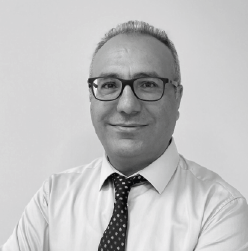
Prof. Müslüm Arıcı
Kocaeli University, İzmit, Turkey (link)
Advanced Thermal Storage and Digital Control: The Future of PCM Applications in Buildings
This talk explores the growing role of phase change materials (PCMs) in improving the energy performance of buildings through enhanced thermal regulation and energy storage. PCMs have the unique ability to absorb and release significant amounts of latent heat during phase transitions, making them highly effective for stabilizing indoor temperatures and reducing reliance on mechanical heating and cooling systems. This talk will provide an overview of the key thermophysical properties of PCMs, material selection criteria, and strategies for integration into building envelopes, such as walls, roofs, and floors, as well as in heating, ventilation, and air conditioning systems. Practical applications and case studies will be discussed to illustrate the real-world benefits and performance of PCMs. Additionally, the thermal performance of PCM will be evaluated by comparing its performance with that of conventional materials. The contribution of phase change materials to sustainable building design, along with their potential role in advancing future energy-efficient construction practices, will be addressed. In particular, the talk will highlight how digitalisation—through simulation tools, building information modelling, sensor-based monitoring, and intelligent control systems—enhances the design, integration, and operational optimization of PCMs. These digital technologies enable more accurate predictions of thermal behavior, support real-time performance evaluation, and facilitate dynamic load shifting and load balancing. By enabling smart energy management, they ultimately maximize the effectiveness of PCM applications in buildings. The talk will also address how digitalisation contributes to peak load reduction, optimized energy use, and improved overall building performance.
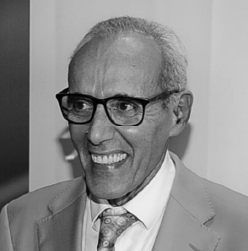
Prof. Abdelilah Benyoussef
Hassan II Academy of Science and Technology, Rabat, Morocco
LaMCScI, Faculty of Sciences, Mohammed V University, Rabat, Morocco
Modeling and Simulation of Advanced Nanomaterials for Hydrogen Production and Storage
Modeling and simulation are powerful tools for understanding, interpreting, and predicting the behavior of complex systems. Complementary to experimental approaches, they not only guide experimental design but also enable the exploration of materials and devices whose fabrication is often costly and time-consuming. Simulations span multiple scales: ab initio calculations and Density Functional Theory (DFT) at the microscopic level; molecular dynamics and Monte Carlo simulations at the mesoscopic level; and finite element methods at the macroscopic level. In materials science, such approaches are essential for the design of novel materials and nanomaterials for applications in energy conversion and storage, magnetic and electric refrigeration, spintronics, valleytronics, and beyond. This presentation focuses on energy conversion and storage, with an emphasis on hydrogen as a clean energy carrier. DFT-based modeling plays a central role in designing new materials, while molecular dynamics and Monte Carlo methods enable the evaluation of their behavior under realistic operating conditions. Achieving sustainable hydrogen production requires renewable energy sources and low-emission processes. Promising routes include electrolysis powered by photovoltaics, concentrating solar power (CSP), or wind turbines ; thermolysis and thermochemical cycles driven by solar energy; photo-electrolysis; and photocatalysis—one of the most promising pathways for green hydrogen generation. For solid-state hydrogen storage, the interaction between hydrogen and the storage material’s surface is critical. Nanostructured materials, offering high specific surface areas, can significantly enhance storage performance. Current research aims to optimize these properties. This work presents the design of advanced nanomaterials for hydrogen production and storage, with particular focus on two-dimensional materials such as phosphorene (a phosphorus-based analogue of graphene), silegraphene, borophene, 2D magnesium hydride, beryllium carbide, and other innovative nanostructures.
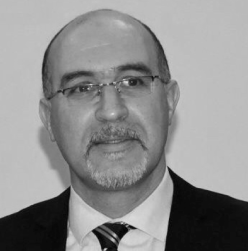
Prof. Mohammed SEAID
Department of Engineering, University of Durham, Durham, UK
International Water Research Institute Mohammed VI Polytechnic University, Benguerir, Morocco
Efficient radiative heat transfer models for high-temperature thermal energy storage: Application to molten-salt reactors
High-Temperature Thermal Energy Storage (HT-TES) is a technology used to store electrical power generated from different energy sources such as combustion, nuclear fusion, solar power. For example, the heat generated through Concentrated Solar Power (CSP) by concentrating mirrors onto a receiver, is used to produce steam that powers turbines connected to generators and thus produces electricity. The main advantage of the CSP technology is the ability to store thermal energy and use it when sunlight is unavailable. Most effective thermal energy storage in CSP systems uses molten salt to operate at high temperatures (more than 500°C) while maintaining excellent thermal storage capacity. In a CSP central tower, the receiver, which is composed of a wall of pipes acting as heat exchangers, absorbs the concentrated sunlight. Thereafter, the cold molten salt, stored in a cold salt tank at around 300°C, is pumped to the receiver via a circulation pump. As the solar radiation heats the receiver, the molten salt is heated and then moved down from the tower to a hot salt tank, where it is stored. The thermal storage system is then discharged during periods of low or no sunlight. These molten salts serve as a heat transfer media that are used to generate the steam driving a turbine connected to an electrical generator. One of the challenges related to the functionality of these reactors is to prevent salts from solidifying. Therefore, to maintain a certain temperature in the pipes, electric resistance elements submerged in the salt-storage tanks are utilised, along with a pipe tracing system. This contribution is expected to address challenges faced daily by engineers in maintaining effectiveness of HT-TES products that cannot be tackled by existing, commercial software. The proposed research is centred on the development of a suite of numerical models and computational methods for radiative heat transfer that will enable engineers to simulate thermal energy processes in considerably more detail than is currently feasible, still within normal engineering time constraints. The resulting software, to be transferred to the industry, will offer an invaluable tool in process optimisation.

Prof. Mohamed Balli
Department of Mechanical Engineering, University of Sherbrooke, Québec, Canada.
AMEEC team, LERMA Lab, College of Engineering and Architecture, International University of Rabat.
Cooling by magnets: Towards efficient and ecofriendly refrigerators
Magnetic refrigeration (heating) which is based on the magnetocaloric effect (MCE), presents numerous advantages when compared to the compressor-based cooling systems such as high thermodynamic efficiency and the absence of harmful fluorinated refrigerants. This “ecofriendly and efficient” technology can be used in several room-temperature applications including domestic refrigeration and air-conditioning. On the other hand, there are also a lot of interests and advantages for using magnetic cooling in the industrial sphere for the liquefaction and storage of cryogenic fluids like hydrogen. The MCE can be described as the isothermal entropy change (ΔS) and/or the adiabatic temperature change (ΔTad) resulting from the variation of the full entropy when subjecting some magnetocaloric materials (refrigerants) to external magnetic fields at temperatures closer to their magnetic ordering points such as Curie temperature TC. Hence, the development of affordable and powerful magnetic refrigerants is critical when it comes to the commercialization of magnetic cooling. For room-temperature applications, the expensive and chemically instable gadolinium metal (Gd) is currently used as an active refrigerant in the vast majority of magnetocaloric devices because of its good magnetocaloric properties close to 294 K, in addition to its ductility and availability in the market. Over the last 2 decades, serious alternatives to Gd such as Fe2P-type compounds, LaFe13-xSix-based materials and some manganite oxides were successfully developed and tested in functional devices with encouraging results. However, the newly reported materials still face several challenges such as mechanical brittleness, chemical instability, large hysteresis and moderate adiabatic temperature change. Also, dysprosium gadolinium aluminum garnet materials (DGAG) were usually used to achieve the refrigeration process at the cryogenic temperature range. Unfortunately, this family of compounds exhibits a large specific heat which negatively impacts their (ΔTad). In parallel to research activities on magnetocaloric materials, several preindustrial magnetic cooling machines were built, and a huge effort was made to optimize their thermodynamic performance. However, the gap to be bridged in going from laboratory prototypes to commercial devices is challenging since there are a lot of issues to be addressed such as the reduction of devices’ cost (and weight), developing powerful magnets and ensuring long-term performance. In this talk, I will discuss recent developments in magnetic cooling and magnetocaloric materials. The practical and fundamental challenges faced by this technology will be analyzed while giving some interesting routes to enhance the performance of both materials and systems.
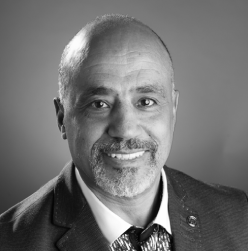
Prof. Jamal Chaouki
Polytechnique Montreal, Montreal, Canada
Electrification of Global Industry: A Technological Approach and Processes to Decarbonization
Electrification of chemical processes is part of the energy transition that aims at reducing the carbon footprint of various industries in the World and specially in Morocco. As the economy is moving away from traditional fossil fuels, renewable energy that is produced is mainly electrical. Therefore, there is a need for the chemical industry, which is traditionally heavy consumer of fossil energy for reactor heating, to adapt their processes to the use of electricity. There are therefore tremendous opportunities to revisit uncconventional heating technologies using electricity that also have demonstrated other benefits in chemical reactions. Process electrification concerns its use to intensify and produce energy. We will give examples relating to Rotating Fixed Beds (RFB) and microwave heating. In this lecture, we will present recent advances in the modeling and optimization of RPBs, with a focus on hydrodynamic behavior analyzed through a custom Eulerian model developed in OpenFOAM. Key insights from parametric studies will be shared, demonstrating the dominant role of rotational speed over other variables such as liquid flow rate or filling ratio — underscoring the superior performance of RPBs compared to conventional packed beds. The second part of the talk will explore the emerging field of microwave-assisted processes for energy-efficient chemical reactions. Thanks to localized heating effects at active sites, microwaves enable selective reaction pathways while limiting undesirable secondary reactions. Case studies on desulfurization of petroleum, lignin pyrolysis, and methane dry reforming will illustrate the promising applications of this technology in complex multiphase systems.
- Distinguished speakers will be announced shortly
Reduced fees (before February 15, 2026)
| Category | Students | Researchers/Academics |
| Public universities (Morocco) | 500 MAD | 1000 MAD |
| Private universities (Morocco) | 1500 MAD | 2000 MAD |
| Maghreb (Algeria, Tunisia, etc.) | 250 EUR | 300 EUR |
| Others | 300 EUR | 350 EUR |
Full fees (after Ferbruary 15, 2026)
| Category | Students | Researchers/Academics |
| Public universities (Morocco) | 800 MAD | 1500 MAD |
| Private universities (Morocco) | 2000 MAD | 2500 MAD |
| Maghreb (Algeria, Tunisia, etc.) | 300 EUR | 350 EUR |
| Others | 350 EUR | 400 EUR |
Registration includes: full access to conference sessions, coffee breaks, lunches, and participant kit.
Venue: Cadi Ayyad University Conferences Center
City: Marrakech, Morocco
- Easily accessible via direct international flights
- Wide range of hotels and accommodations for all budgets
- Club of the university with economical rates. It is located 300m from the conference center. Prices will be communicated soon.
- Optional cultural and tourist excursions can be arranged during the congress.
Email:
Phone and WhatsApp: 00212621785551 (Prof. Hamza Faraji)
Academic Organizers and Partners
Principal and Technical Sponsors

Rejoignez l'AMT!
Rejoindre l’AMT, c’est intégrer une communauté active de plus de 200 membres engagés dans le développement des sciences thermiques au Maroc et à l’international.

